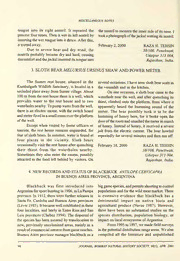
4. new Records and Status of Blackbuck Antilope Cervicapra in Buenos Aires Province, Argentina PDF
Preview 4. new Records and Status of Blackbuck Antilope Cervicapra in Buenos Aires Province, Argentina
MISCELLANEOUSNOTES tongue into its right nostril. It repeated the the nostrilto moistenthe inner side ofits nose. I process fourtimes. Thenitwetits leftnostrilby tookaphotographofthejackalwettingitsnostril. insertingthe wettongue into itthrice. Afterthis, ittrottedaway. February 2, 2000 RAZA H. TEHSIN Due to severe heat and dry wind, the 38/106, Panchwati, nostrils probably became dry and hard, causing Udaipur 313 004, discomfortandthejackalinserteditstongueinto Rajasthan, India. SLOTH BEARMELURSUS URSINUSSHAW AND POWER METER 3. The Sumer rest house, situated in the several occasions, Ihave seen slothbearscats in Kumbalgarh Wildlife Sanctuary, is located in a the verandah and in the kitchen. secludedplace away from Sumervillage. About On one occasion, a slothbear came to the m 100 fromthe resthousethere is awell, which waterhole near the well, and after quenching its provides water to the rest house and to two thirst, climbed onto the platform, from where it waterholesnearby.Topumpwaterfromthewell, apparently heard the humming sound of the there is an electric motor, with the switchboard meter. The bear possibly took it to be the andmeterfixedinasmallroomovertheplatform humming of honey bees, for it broke open the ofthe well. dooroftheroomandsmashedthemeterinsearch Except when visited by forest officers or ofhoney. Instead ofhoney, it received a severe tourists, the rest house remains unguarded, for jolt from the electric current. The bear howled fearofslothbears. In summer, wateris found at repeatedly for several minutes and then ran off. four places in the vicinity. Sloth bears occasionallyvisitthe resthouse afterquenching February 18, 2000 RAZA H. TEHSIN their thirst from the waterholes nearby. 38/106, Panchwati, Sometimes they also enter the rooms, possibly Udaipur 313 004, attracted to the food left behind by visitors. On Rajasthan, India. 4. NEW RECORDS AND STATUS OF BLACKBUCK ANTILOPE CERVICAPRA IN BUENOS AIRES PROVINCE, ARGENTINA Blackbuck was first introduced into biggamespecies,andpermitsshootingtocontrol Argentinaforsporthuntingin 1906,inLaPampa populations andforthe wildmeatmarket. There province. In 1912, there were furtherreleases in is extensive evidence that blackbuck has a Santa Fe, Cordoba and Buenos Aires provinces detrimental impact on native biota and (Lever 1985).Itbecamewellestablishedinthese agricultural produce (Navas 1987). However, four localities, and lately in Entre Rios and San there have been no substantial studies on the Luis provinces (Chebez 1994). The dispersal of species distribution, population biology, or the species has been assisted by translocationto impact on local ecosystems ofArgentina. new, previously uncolonized areas, mainly as a From 1995 to 1997,wemadefieldsurveys resultofcommercialinterestfromgameranches. inthepotentialdistributionrangeareas. We also Buenos Aires province manages blackbuck as a compiled all the literature and unpublished 98 JOURNAL, BOMBAYNATURAL HISTORYSOCIETY, 98(1), APR. 2001 MISCELLANEOUSNOTES information atthe local Wildlife Department, to better established population has its nucleus in determine the current distribution and status of ‘La Corona’ and ‘La Guarida del Zorro’ game Antilope cervicapra in Buenos Aires province. ranches, an area ofapproximately 12,000 ha, in There are 11 game ranches (50% of the General Belgrano near the Chascomus district totallegallyestablishedranches)withblackbuck boundary. In 1996,frompreliminarylinetransect populations. The sport hunting season censuses, we estimated a population of above traditionally opens from March 15 and extends 6,000 animals, with a density of0.56 individual to December 31, based on the notionthat fawns per hectare. However, in 1997, the population are born in summer (January and February). wascommerciallyharvestedforthemeatmarket, Despite this, there are records from captive and showing a marked decline since this event. We wild populations about females giving birth suggestfurtherstudies onthe species’ impacton throughoutthe year. 53 male trophieshavebeen local biota, to stop uncontrolled translocations, legally taken from game ranches in 1995, 44 in andaclosermonitoringoftheeffectofsportand 1996 and 103 in 1997, most ofthemby foreign commercial harvesting on the blackbuck. hunters. In 1997, there was at least one permit We thank Claudio and Sergio Quagliata issued for commercial harvesting. fortheirhelpinthe fieldcensusesandforaccess The previous record of distribution to their captive population. (Galliari et al. 1991) has now been expanded. Weconfirmedtheoccurrenceofblackbuckatthe March 2, 2000 BRUNO CARPINETTI Chascomus, General Belgrano, Castelli, Bahia Direccion de Administracion Blanca and Guamini departments. Additionally, de Recursos Naturales, new records were made for the species at Pila, Ministerio de Asuntos Agrarios Dolores, Adolfo Alsina, Coronel Suarez and de la Prov. de Bs. Aires, N Coronel Dorrego departments. The biggest and Calle 71 488, La Plata (1900), Argentina. Refer nces : Chebez,J.C. (1994):Losquesevan,especiesargentines naturalesenlaevaluacionambiental. enpeligro. EditorialAlbatrossSACI,BuenosAires. Lever,C.H. (1985): Naturalisedmammalsoftheworld. Galliari, C.A., W.D. Berman & F.J. Goin (1991): LongmansInc.,NewYork,USA. Mamiferos.Comisiondeinvestigacionescientificas Navas,J.R.(1987):Losvertebradosexoticosintroducidos delaProvinciadeBuenosAires.SituacionAmbiental en laArgentina. Rev. Mus. Arg. Cs. Nat., Zoologia delaProvinciadeBuenosAires.A-Recursosyrasgos 14:7-38. INCIDENCE OF AN ELEPHANT CALF ELEPHASMAXIMUS 5. TRAPPED BETWEEN TWO TREE TRUNKS The first year is consideredto be the most rateinIndianelephantcalves(Elephasmaximus , vulnerable stage in an elephant’s life, when age<5years),inBiligiriRanganTempleWildlife mortalityraterangesfrom 10%to30%(Douglas Sanctuary, SouthIndia, wasreportedtobe4-5% 1972, Barnett 1991). Annual mortality rate of infemale and 8-9% inmale elephants (Sukumar elephant calves aged less than one year is 1989). Elephant calves are known to die of reported to be 36% in Tsavo National Park, diseases,intra-specificfights,drowninginfloods, Kenya(Laws 1969). Studiesonannualmortality landslides, tigerpredation, snakebitepoisoning, JOURNAL, BOMBAYNATURAL HISTORYSOCIETY, 98(1),APR. 2001 99
